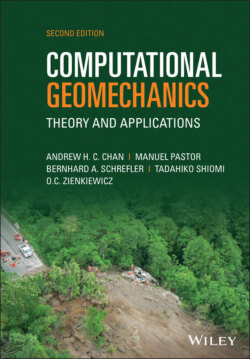Читать книгу Computational Geomechanics - Manuel Pastor - Страница 46
3.2.5 The Structure of the Numerical Equations Illustrated by their Linear Equivalent
ОглавлениеIf complete saturation is assumed together with a linear form of the constitutive law, we can write the effective stress simply as
(3.62)
We can now reduce the governing u–p Equations (3.23) and (3.28) to the form given below
(3.63)
and
(3.64)
where =
(3.65)
is the well‐known elastic stiffness matrix which is always symmetric in form. S and H are again symmetric matrices defined in (3.31) and (3.30) and is as defined in (3.29).
The overall system can be written in the terms of the variable set [, ]T as
(3.66)
Once again the uncoupled nature of the problem under drained condition is evident (by dropping the time derivatives) giving
(3.67)
in which can be separately determined by solving the second equation. For undrained behavior, we can integrate the second equation when H = 0 and obtain an antisymmetric system which can be made symmetric by multiplying the second equation by minus unity (Zienkiewicz and Taylor 1985)
(3.68)
It is interesting to observe that in the steady state, we have a matrix which, in the absence of fluid compressibility, results in
(3.69)
which only can have a unique solution when the number of variables nu is greater than the number of variables np. This is one of the requirements of the patch test of Zienkiewicz et al. (1986a, 1986b) and of the Babuska‐Brezzi (Babuska 1973 and Brezzi 1974) condition.
